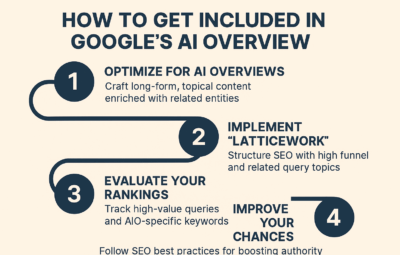The Top 10 Search Engine Optimization Resources You Need Right Now
- December 29, 2023
- Business Marketing
Best search engine optimization resources?
There are various resources available for search engine optimization (SEO) that can help improve website rankings and visibility on search engines. Some of the best resources include:
1. Moz: Moz offers a range of SEO tools, guides, and educational resources. Their blog, “Moz Blog,” is a great source of actionable tips and strategies.
2. Search Engine Land: This website provides comprehensive coverage of SEO news and updates, along with guides, expert columns, and analysis.
3. Google Webmaster Central: Google's own resource, it provides tools like Google Search Console and offers documentation, blog posts, and videos to help understand and optimize for Google's search algorithms.
4. SEMrush: An all-in-one SEO tool, SEMrush provides keyword research, backlink analysis, competitor research, and site audit features. They also have a helpful blog with SEO guides and tips.
5. Ahrefs: A popular SEO tool, Ahrefs offers competitive analysis, keyword research, content research, and backlink analysis. They have a blog that covers various SEO topics and offers tutorials.
6. Backlinko: Run by SEO expert Brian Dean, Backlinko focuses on actionable strategies for improving SEO. Their blog offers detailed guides, case studies, and video tutorials.
7. Yoast SEO: Yoast offers a WordPress plugin for on-page SEO optimization. Their blog covers various SEO topics, providing practical tips and insights.
8. Neil Patel: A well-known digital marketer, Neil Patel offers comprehensive guides and tutorials on SEO, content marketing, and digital marketing through his blog and YouTube channel.
These resources offer valuable insights, tools, and techniques that can improve your website's SEO performance, help you keep up with industry trends, and drive more organic traffic to your site.
Best search engine optimisation tool?
There are a variety of search engine optimization (SEO) tools available, and the “best” tool can vary depending on individual needs and preferences. Some popular and highly regarded SEO tools include:
1. Google Search Console: This tool provides insights into website performance, crawl statistics, indexing status, and more. It helps optimize website visibility on Google search engine.
2. Ahrefs: A comprehensive SEO toolset that offers backlink analysis, keyword research, competitor analysis, and more.
3. SEMrush: A powerful tool for keyword research, on-page SEO optimization, competitor analysis, and tracking website performance.
4. Moz Pro: Offers features like keyword research, link analysis, rank tracking, site audits, and more to aid in optimizing website performance.
5. Yoast SEO: A popular WordPress plugin that helps optimize website content for better search engine rankings and offers real-time suggestions for on-page SEO.
6. Screaming Frog: A tool for comprehensive website audits, meta tag optimization, link analysis, and site structure analysis.
These are just a few examples, and it's important to consider individual requirements and priorities when determining the best SEO tool for a specific situation.
Best search engine optimization practices?
Some of the best search engine optimization (SEO) practices include:
1. Keyword research: Conducting thorough keyword research helps identify relevant and high-ranking keywords to target in website content and meta tags.
2. Creating high-quality content: Focus on creating valuable, informative, and engaging content that resonates well with your target audience. This includes using relevant keywords naturally within the content.
3. Title tags and meta descriptions: Optimizing title tags and meta descriptions with relevant keywords helps search engines understand what your page is about, increasing the likelihood of ranking higher in search results.
4. Mobile-friendliness: Ensure that your website is mobile-friendly and responsive, as search engines prioritize mobile-optimized sites.
5. Site speed optimization: Improve page load times through techniques like image optimization, caching, and minifying code. Faster-loading websites tend to have better rankings.
6. URL structure: Use descriptive, user-friendly URLs that include relevant keywords, making it easier for search engines and users to understand the page's content.
7. Internal linking: Create a logical internal linking structure within your website to help search engines navigate and understand the hierarchy of your content.
8. External linking: Build high-quality backlinks from authoritative and relevant websites to increase your site's credibility and organic search visibility.
9. Social media integration: Incorporate social sharing buttons and encourage users to share your content, potentially increasing visibility and traffic.
10. Regularly updating and refreshing content: Keep content fresh and up-to-date to ensure search engines consider your website as relevant and useful.
11. User experience optimization: Create a positive user experience by having a user-friendly interface, easy navigation, and fast-loading pages, which encourages visitors to stay longer.
12. Regular monitoring and analysis: Regularly track and analyze your SEO efforts using analytics tools to identify areas for improvement and adjust your strategy accordingly.
Remember, search engine optimization is an ongoing process that requires continuous optimization and adaptation to ensure optimal performance in search results.
Why do search engine optimisation?
Search engine optimization (SEO) is done to improve a website's visibility and ranking on search engine results pages (SERPs). There are several reasons why businesses and website owners invest in SEO:
1. Increased organic traffic: SEO helps in driving targeted and relevant organic traffic to a website. By optimizing the website's content and structure, it becomes more likely to appear in top search results, attracting more visitors.
2. Better user experience: SEO involves optimizing website design, layout, and content to enhance user experience. This can include improving page loading speed, making it mobile-friendly, and ensuring easy navigation. A positive user experience leads to increased engagement, longer visit durations, and higher chances of conversion.
3. Higher search engine rankings: By following SEO best practices, websites can improve their rankings on search engine result pages. Higher rankings mean increased visibility, credibility, and trustworthiness, as users often perceive top-ranked websites as more reliable and relevant.
4. Improved brand visibility and recognition: Ranking high on search results increases a website's visibility and brand exposure. Users are more likely to remember and recognize a brand when they see it frequently during their search queries.
5. Cost-effective marketing strategy: Compared to other digital marketing strategies like paid advertising, SEO can provide long-term and sustainable results without high advertising costs. Once a website gains a good ranking through SEO, it can attract consistent organic traffic without ongoing advertising expenses.
6. Beat the competition: In today's digital landscape, almost every industry has high competition. SEO helps businesses stay ahead by optimizing their websites to outrank competitors on search results, increasing the chances of attracting potential customers.
Overall, search engine optimization is essential for businesses that want to establish a strong online presence, drive organic traffic, increase visibility, and achieve sustainable growth in the digital landscape.
How search engine optimization works?
Search engine optimization (SEO) is the practice of improving a website's visibility and ranking on search engine results pages (SERPs) to drive organic or unpaid traffic to the site.
Here's a general overview of how SEO works:
1. Keyword Research: Conducting keyword research is the first step in SEO. This involves identifying the words and phrases that people are searching for in search engines related to your website's content or industry.
2. On-Page Optimization: On-page optimization involves optimizing various elements on your website to make it more attractive to search engines. This includes optimizing page titles, meta descriptions, headings, URL structure, and content for relevant keywords. Additionally, optimizing images, improving site speed, and ensuring mobile-friendliness are important factors.
3. Technical SEO: Technical SEO involves optimizing the technical aspects of a website to make it easier for search engine crawlers to understand and index the site. This can include improving site structure, fixing broken links, optimizing robots.txt and XML sitemaps, and improving website loading speed.
4. Off-Page Optimization: Off-page optimization refers to activities done outside of your website to improve its visibility and authority. This includes link building, which involves obtaining quality backlinks from other authoritative websites. Social media sharing, guest posting, influencer outreach, and online reputation management also fall under off-page optimization.
5. Content Creation and Optimization: Creating high-quality, informative, and relevant content is crucial for SEO. Search engines prioritize websites that provide valuable content to users. Regularly creating and optimizing content with targeted keywords can help improve your website's visibility and attract organic traffic.
6. User Experience: Ensuring a positive user experience is vital for SEO. Factors such as website navigation, ease of use, responsiveness, and providing relevant and valuable content contribute to a good user experience, which can, in turn, improve your search rankings.
7. Tracking and Analysis: Monitoring the performance of your SEO efforts is essential. Tools like Google Analytics and Google Search Console allow you to track website traffic, keyword rankings, and user behavior to make data-driven improvements.
It is important to note that SEO is a long-term process and requires continuous efforts to achieve and maintain higher search engine rankings. The tactics and strategies used in SEO may also evolve over time as search engines update their algorithms.
Best seo practices 2023?
Predicting the best SEO practices for 2023 is subjective and speculative as SEO practices are constantly evolving and can vary depending on trends, algorithm updates, and search engine guidelines. However, based on current trends and advancements, some potential best SEO practices for 2023 may include:
1. Mobile optimization: With the increasing use of mobile devices, optimizing websites for mobile responsiveness and load times will be essential. This includes implementing responsive design, AMP (Accelerated Mobile Pages), and ensuring a seamless user experience on mobile devices.
2. User experience (UX): Search engines prioritize websites that provide a great user experience. Focusing on factors such as site speed, easy navigation, relevant content, and engaging design will continue to be crucial for SEO success.
3. High-quality and relevant content: Creating valuable, comprehensive, and engaging content that addresses user search intent will remain a key SEO practice. Emphasizing quality over quantity, incorporating multimedia, and using structured data to enhance content visibility may be important in 2023.
4. Voice search optimization: As voice-assisted devices like smart speakers and voice search on mobile devices grow in popularity, optimizing content for voice searches will become increasingly important. This involves using conversational language, incorporating long-tail keywords, and providing concise answers to common questions.
5. E-A-T (Expertise, Authoritativeness, Trustworthiness): Building a strong online reputation by establishing expertise, authoritativeness, and trustworthiness in a specific industry or niche will continue to be crucial for SEO. This can be achieved through quality backlinks, positive user reviews, and establishing a strong brand presence.
6. AI and machine learning: As search engines continue to evolve, AI and machine learning algorithms will play a larger role in ranking websites. Staying updated with advancements and utilizing AI-driven tools and strategies may give websites an edge in SEO.
It's important to note that SEO practices can change rapidly, so it's crucial to stay updated with industry news, search engine guidelines, and algorithm updates to adapt accordingly.
How seo works?
SEO, which stands for Search Engine Optimization, is the practice of enhancing a website's visibility and ranking in search engine results pages (SERPs). It involves several strategies, techniques, and tactics to increase organic (non-paid) website traffic.
1. Keyword Research: Identifying and targeting relevant keywords that users search for on search engines.
2. On-Page Optimization: Optimizing various elements within a website including meta tags, titles, headings, content, and URL structure to make them more relevant to the targeted keywords.
3. Content Creation: Producing high-quality and valuable content that satisfies user intent. This includes blog posts, articles, videos, infographics, and more.
4. Link Building: Acquiring backlinks from other authoritative and relevant websites to boost the website's credibility and search engine rankings.
5. Technical SEO: Optimizing technical aspects of a website, such as site speed, mobile-friendliness, crawlability, and indexability, to improve user experience and search engine visibility.
6. User Experience (UX): Improving the overall user experience by ensuring easy navigation, fast page load speed, responsive design, and user-friendly interfaces.
7. Local SEO: For businesses targeting local customers, optimizing the website for local search queries and implementing location-based strategies.
8. Analytics and Monitoring: Regularly monitoring website performance using tools like Google Analytics to track traffic, user behavior, keyword rankings, and making data-driven optimizations.
It's important to note that SEO is an ongoing process rather than a one-time task, as algorithms and user preferences constantly evolve. Regular monitoring, optimizations, and staying up-to-date with industry trends are essential to maintain and improve SEO effectiveness.
Best seo practices?
Best SEO practices refer to a set of techniques and strategies that help improve a website's visibility and search engine rankings. Some of the best SEO practices include:
1. On-page optimization: This involves optimizing various elements of a webpage such as title tags, meta descriptions, URLs, headings, and content to make them more relevant to targeted keywords.
2. Keyword research: Conducting thorough keyword research to identify the most relevant and high-volume keywords that align with your website's content and objectives. Incorporating these keywords strategically in your website's content can boost your visibility on search engine result pages (SERPs).
3. High-quality content: Creating unique, informative, and engaging content that provides value to users and addresses their queries. Focus on creating content that is keyword-rich, properly structured, and optimized for search engines.
4. Mobile optimization: With the increasing use of mobile devices for internet browsing, it is essential to ensure your website is mobile-friendly and provides a seamless user experience across different screen sizes.
5. Technical optimization: Optimizing technical aspects of a website, such as page load speed, crawlability, indexing, XML sitemaps, and robots.txt files, to ensure search engines can effectively crawl and index your site, leading to better rankings.
6. Link building: Building a strong and diverse backlink profile by acquiring high-quality and relevant links from reputable websites. This can be achieved through various methods such as guest blogging, influencer outreach, and content promotion.
7. User experience optimization: Ensuring that your website is easy to navigate, visually appealing, and provides a positive user experience. This includes improving site architecture, reducing bounce rates, and optimizing site performance.
8. Social media integration: Leveraging social media platforms to promote your content, engage with your audience, and increase brand visibility. Sharing your content on social media can help drive traffic and potentially acquire valuable backlinks.
9. Regular monitoring and analysis: Continuously monitoring your website's performance using various SEO tools and analyzing key metrics such as organic traffic, keyword rankings, and user behavior. This allows you to identify areas for improvement and make data-driven decisions.
10. Staying up-to-date with algorithm changes: Keeping up with search engine algorithm updates and ensuring your SEO strategies align with the latest best practices and guidelines. This ensures that your website remains relevant and maintains its visibility in search results.
How does search engine optimization work?
Search engine optimization (SEO) involves various strategies and techniques to improve a website's visibility and ranking on search engine results pages (SERPs). Here is a general overview of how SEO works:
1. Keyword Research: The process starts with identifying relevant keywords and phrases that users often search for, related to the website's content, products, or services.
2. On-Page Optimization: This involves optimizing the website's elements such as page titles, meta descriptions, headings, content, URL structure, and internal linking to make it search engine friendly and relevant to the target keywords.
3. Technical SEO: It focuses on the website's technical aspects, including site speed, mobile-friendliness, crawlability, indexability, URL structure, and XML sitemap, to ensure search engines can easily access and understand the website's content.
4. Content Creation: Creating high-quality, informative, and relevant content is crucial for SEO. This includes regular blog posts, articles, videos, or any other content that not only engages users but also provides value and answers their queries.
5. Link Building: Building high-quality, authoritative backlinks from other reputable websites is an essential aspect of SEO. Links from well-established websites can help improve a website's credibility and visibility on search engines.
6. User Experience: Providing a positive and seamless user experience is essential for SEO success. This includes having a well-designed website, easy navigation, fast-loading pages, and a mobile-friendly layout.
7. Analytics and Monitoring: Regularly monitoring and analyzing website traffic, rankings, and user behavior using tools like Google Analytics helps identify areas for improvement and measure the effectiveness of SEO strategies.
It's important to note that SEO is an ongoing process, and it takes time and effort to see significant results. Additionally, search engines continuously update their algorithms to provide better search experiences, which means SEO practices need to adapt accordingly.
What is SEO and How Can It Help Your Website?
Search Engine Optimization (SEO) is a strategy used to increase a website's visibility and ranking on search engine results pages. By optimizing a website's content, keywords, and structure, SEO aims to drive organic traffic and attract potential customers to the site. This can ultimately lead to increased website traffic, brand visibility, and potential sales. In this article, we will explore the basics of SEO and the ways it can benefit your website in terms of driving more traffic and achieving better rankings on search engines.
What Resources Should You Use to Improve Your SEO Performance?
To improve SEO performance, it's essential to utilize a mix of free and paid resources to stay ahead of the ever-changing search landscape. The Moz Beginners Guide to SEO and the Linkio guide to SEO are excellent free resources for beginners, providing comprehensive insights into SEO best practices. For more advanced strategies, Neil Patel's article on SEO content offers valuable tips and techniques.
Staying updated on industry changes is crucial for success, and the Search Engine Land newsletter delivers the latest news and updates on search algorithms. Additionally, the Hubspot Inbound Certification offers in-depth training on SEO and content marketing, providing valuable insights for a fee.
It's important to emphasize the significance of staying updated on changes to search algorithms and adhering to Google's guidelines to remain competitive in search rankings. Utilizing these resources, whether free or paid, can help improve SEO performance and achieve better results for your website.
Understanding Search Engine Algorithms
Search engine algorithms are the complex formulas and protocols that search engines use to determine the ranking of web pages in search results. Understanding these algorithms is crucial for businesses and website owners wanting to improve their online visibility and attract more traffic. In this article, we will delve into the intricacies of search engine algorithms, exploring the key factors that influence ranking and how to optimize your website accordingly. We will also discuss the importance of staying updated with algorithm updates and best practices for achieving higher search engine rankings. Whether you are new to the world of SEO or looking to deepen your understanding, this article will provide valuable insights into the working of search engine algorithms.
The Basics of Search Algorithm Optimization
Search algorithm optimization is the process of improving the visibility of a website in search engine results. It is important to prioritize organic search, which refers to traffic driven to a website through unpaid search results. To achieve this, various tools such as keyword research, link building, and content optimization are used to improve search rankings. A comprehensive SEO strategy is crucial for success, encompassing both on-page and off-page optimization, as well as technical elements to ensure a well-rounded approach.
However, maintaining an effective SEO strategy can be challenging due to constant changes in search engine algorithms and the evolving competitive landscape. Google's SEO Starter Guide is a valuable resource that offers insights into optimizing websites for search, helping to overcome these challenges. It outlines best practices for website structure, content, and technical considerations to improve visibility in search results.
In summary, search algorithm optimization involves prioritizing organic search, utilizing tools to improve rankings, and developing a balanced SEO strategy. Overcoming the challenges of maintaining an effective strategy can be assisted by using resources such as Google's SEO Starter Guide.
How to Track and Monitor Search Algorithm Changes
Tracking and monitoring search algorithm changes is crucial for understanding how they may impact your website's search ranking. Top websites and blogs that provide information on tracking and monitoring search algorithm changes include Search Engine Watch, Link Redirect Trace, Moz, SEMrush, and Ahrefs.
It's important to stay updated on search engine updates and algorithm changes because they can have a significant impact on your website's search ranking. By tracking search algorithm changes, you can gain insights into how these updates may affect your website's visibility and traffic. Understanding these changes allows you to make necessary adjustments to your SEO strategy to maintain or improve your search ranking.
Tracking and monitoring search algorithm changes also helps you stay ahead of the competition and adapt to the evolving search landscape. By staying informed about algorithm updates, you can proactively optimize your website for better search engine ranking and ensure that your SEO efforts are aligned with current best practices.
In conclusion, tracking search algorithm changes is essential for understanding their potential impact on your website's search ranking and for making informed decisions to optimize your SEO strategy.
Tools for Analyzing Search Algorithms
There are several SEO tools available for analyzing search algorithms and optimizing search engine ranking. One of the best tools is SEMrush, which offers features such as keyword research, backlink analysis, site audit, and position tracking. It provides valuable insights into which keywords are driving traffic to a website and helps in understanding the search engine algorithms.
Another powerful tool is Ahrefs, known for its comprehensive backlink analysis and keyword research capabilities. Ahrefs also provides data on organic search, paid search, and backlink profiles, enabling website owners to adapt to search engine algorithms and improve their visibility.
Moz Pro is another essential tool for analyzing search algorithms with features like keyword research, on-page optimization, link building, and site audits. It helps in understanding and adapting to search engine algorithms to improve website visibility by providing valuable insights into website performance and ranking factors.
These tools aid in optimizing search engine ranking by providing in-depth analysis, strategies, and recommendations for improving website visibility. By utilizing these SEO tools, website owners can gain a competitive edge in the online market and stay ahead of the constantly evolving search engine algorithms.
Keyword Research Strategies
Introduction: Keyword research is a crucial component of any successful digital marketing strategy. By understanding the specific words and phrases potential customers are using to search for products and services, businesses can optimize their content to better rank in search engine results. In this article, we will explore the importance of keyword research and examine different strategies to effectively identify the most valuable keywords for your business.
1. Importance of Keyword Research
Keyword research is essential for understanding the language and intent of your target audience. By identifying the most relevant and high-traffic keywords, businesses can tailor their content to attract the right kind of traffic and improve their conversion rates. This section will delve into the various benefits and implications of thorough keyword research for your marketing efforts.
2. Tools for Keyword Research
There are numerous tools available to aid in the process of keyword research, from free options like Google's Keyword Planner to more advanced paid tools such as SEMrush and Ahrefs. This section will explore the different tools and their features, helping you determine the best options for your specific needs.
3. Choosing the Right Keywords
Selecting the right keywords is a combination of research, analysis, and understanding your target audience. This section will outline different strategies for identifying and choosing the most effective keywords for your business, from long-tail keywords to competitive analysis.
How to Identify Relevant Keywords and Phrases
Essential elements of SEO include on-page optimization, off-page factors, and technical aspects. Relevant keywords are crucial for on-page optimization as they help search engines understand the content's topic and relevance. By incorporating relevant keywords into website content, meta tags, and headers, websites can rank higher in search results and attract the right audience.
To find keywords with high search volume and low competition, keyword research tools like Google Keyword Planner, SEMrush, and Ahrefs can be used to identify popular search terms and competition levels. Generating a list of LSI (latent semantic indexing) keywords can also enhance content relevance and improve rankings by incorporating related terms and phrases. Additionally, analyzing successful competitor keywords through tools like SEMrush and Ahrefs can provide insights into effective keywords for targeting similar audiences.
In conclusion, SEO relies heavily on relevant keywords to improve search rankings and attract the desired audience. Conducting thorough keyword research, including finding high-volume, low-competition keywords and generating LSI keywords, is essential for developing an effective SEO strategy and staying ahead of competitors.
Tools for Finding Accurate Search Volume Data
Accurate search volume data is crucial for effective keyword research and implementing successful SEO strategies. Some top tools for finding accurate search volume data include:
1. Google Keyword Planner: This tool provides search volume data directly from Google's database, offering accurate and reliable information. It also offers keyword suggestions, historical statistics, and the ability to filter by location and language.
2. SEMrush: SEMrush is a comprehensive SEO tool that provides detailed search volume data for individual keywords, as well as related keywords and their search volumes. It also offers competitive analysis, keyword difficulty, and trend data.
3. Ahrefs: Ahrefs offers accurate search volume data with the ability to see global search volumes, as well as search volumes by country. It also provides insights into keyword difficulty, SERP analysis, and keyword suggestions.
4. Moz Keyword Explorer: Moz's tool provides accurate search volume data along with keyword difficulty scores and organic click-through rates. It also offers suggestions for related keywords and SERP analysis.
These tools have the capability to provide accurate search volume data, allowing for informed keyword research and successful SEO strategies. It's important to utilize tools that offer precise and reliable data to ensure the effectiveness of your SEO efforts.
Analyzing Keyword Difficulty to Maximize Results
To analyze keyword difficulty and maximize results, start by using keyword research tools such as Ahrefs, SEMrush or Google Keyword Planner to find keywords with high search volume and low competition. This will help you identify keywords that are easier to rank for and have a higher chance of driving traffic to your website.
In addition to this, it's important to identify primary and secondary keywords wisely. Primary keywords should be higher volume, higher difficulty keywords that are directly related to the content on your website, while secondary keywords should be long-tail keywords that are less competitive and more specific to your niche.
Once you have identified your target keywords, use keyword research tools to get traffic forecasts for those keywords. This will help you estimate the potential traffic you can expect to generate by ranking for those keywords.
Finally, to further optimize your keyword strategy, generate a list of latent semantic indexing (LSI) keywords. These are keywords that are semantically related to your target keywords and can help search engines understand the context of your content better, ultimately helping you to rank for a wider range of related keywords.
By following these steps and taking advantage of keyword research tools, you can better understand keyword difficulty, target keywords with high search volume and low competition, and ultimately maximize your results in terms of driving organic traffic to your website.
Generating New Ideas for Targeted Keywords
The top keyword research tools for generating new ideas for targeted keywords are Google's Keyword Planner and Keyword Tool. These tools can be used to find relevant keywords with high search volume and low competition by allowing users to input specific terms or phrases and then provide a list of related keywords along with their search volume and competition level.
The free version of Google's Keyword Planner provides basic keyword suggestions and search volume data, while the paid version offers more advanced features such as historical statistics, forecast data, and the ability to create and save keyword lists. The paid version also allows users to access Google's full range of keyword data and insights for a monthly fee.
On the other hand, Keyword Tool offers both free and paid versions, with the free version providing basic keyword suggestions and search volume data, and the paid version offering more advanced features such as search volume trends, competition level, and the ability to export data.
Overall, these keyword research tools can help users identify relevant keywords with high search volume and low competition, but the advanced features and full access to keyword data are often only available in the paid versions, which come with varying costs depending on the features and insights offered.
Technical SEO Best Practices
Technical SEO Best Practices focus on optimizing the technical aspects of a website in order to improve its search engine visibility and performance. By implementing best practices such as optimizing site speed, improving site architecture, and ensuring proper indexing of content, website owners can ensure that their site is easily accessible and understandable by search engines. These practices not only improve the user experience, but also contribute to higher search rankings and increased organic traffic. In this article, we will explore some key technical SEO best practices that every website owner should consider implementing in order to enhance their website's performance and visibility in search engine results.
Optimizing Site Load Speed and Performance
To optimize the site load speed and performance, start by using Google's Mobile-Friendly Test and Page Speed Insights tools. The Mobile-Friendly Test helps ensure your website is well-optimized for mobile devices, while Page Speed Insights provides recommendations for improving loading times.
Based on the suggestions from these tools, make necessary adjustments such as minimizing server response time, leveraging browser caching, and enabling compression. Optimizing images and eliminating render-blocking JavaScript and CSS can also significantly improve site performance.
Also, utilize Google Analytics to track important metrics such as page loading speed and user behavior. This data can help identify areas for improvement and measure the impact of the changes made.
By implementing the recommendations from both Google's Mobile-Friendly Test and Page Speed Insights tools, as well as monitoring key metrics through Google Analytics, you can enhance the mobile-friendliness and speed of your website, ultimately improving the overall user experience.
Improving Internal Link Structure and Navigation
To improve internal link structure and navigation, start by using tools like Check My Links and Ahrefs Backlink Checker to identify and fix broken links on your website. Additionally, use Ahrefs Backlink Checker to analyze competitors' backlinks for inspiration on potential link opportunities.
When analyzing the internal link structure, consider the website's domain rating, number of backlinks, and number of referring domains. These metrics can provide insights into the strength and authority of your internal links.
Incorporate relevant keywords into anchor text to improve the relevance and SEO value of internal links. Use descriptive and relevant anchor text that clearly indicates the content of the linked page.
By following these steps and leveraging tools like Check My Links and Ahrefs Backlink Checker, you can enhance the internal link structure and navigation of your website, ultimately improving user experience and search engine optimization.
Spotting Broken Links, Errors, and Duplicate Content
To identify and address broken links, errors, and duplicate content on your webpages using the Check My Links extension for Google Chrome, follow these steps:
1. Install the Check My Links extension for Google Chrome.
2. Open the webpage you want to check for broken links.
3. Click on the Check My Links icon in the Chrome toolbar to start the link checking process.
4. The extension will identify broken links, highlight them in red, and display the number of valid and broken links on the webpage.
5. You can then export the list of broken links for further analysis and action.
6. Review the status codes and color-coded results provided by the extension to address any errors or duplicate content that may be affecting your webpage's efficiency.
By using Check My Links, you can easily spot broken links, errors, and duplicate content on your webpage, allowing you to take necessary actions to improve the user experience and SEO performance.
About us and this blog
We are a digital marketing company with a focus on helping our customers achieve great results across several key areas.
Request a free quote
We offer professional SEO services that help websites increase their organic search score drastically in order to compete for the highest rankings even when it comes to highly competitive keywords.
Recent Posts
View all projectsMore from our blog
See all postsRecent Posts
- How to Promote Last-Minute Black Friday Deals with SEO, AIO Search Fast With Online Advantages November 21, 2025
- The AI Overview Detective: How to Confirm Your Featured Status September 10, 2025
- Google Ads: Take Back Control of Your Online Experience September 10, 2025
















